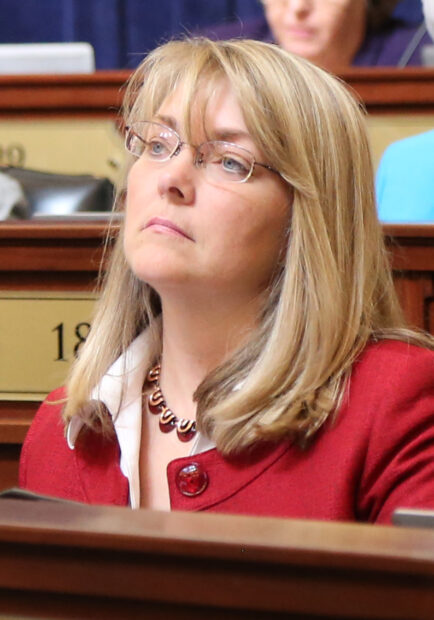RIGBY — A gunman at Platte Canyon High in Bailey, Colo., traipsed the school for 35 minutes before taking seven female students hostage.
Sixteen-year-old Emily Keyes sent a text message to her parents while held at gun point in a locked room with six of her classmates.
“I love u guys,” she wrote.
Moments later, 53-year-old Duane Roger Morrison shot Keyes in the head and then killed himself. The remaining hostages escaped unharmed.
Following the 2006 crisis, Keyes’ parents started a nonprofit that helps schools develop standard response protocol for emergency situations. They called it the I Love U Guys Foundation, and schools across the country have been adopting it.
This year, the model is being implemented in East Idaho’s Jefferson County School District.

“You’ve got to have something in place,” said Superintendent Lisa Sherick. “Even just addressing the issue and letting people know that you have something is very important.”
Sherick and other administrators in the district say they chose I Love U Guys’ standard response protocol because of its simple, yet comprehensive, approach to school safety, as well as its emphasis on including parents and first responders in districtwide emergency planning.
Jefferson’s implementation of the protocol comes at the heels of the state’s newly formed Office of School Safety and Security, which will keep tabs on what districts are doing to perform risk and threat assessments at all Idaho public schools.
Sherick says the I Love U Guys model addresses gaps in school security protocols that have existed for decades.
“A few years ago, we started looking at what we had in place in schools throughout the district and what we realized was that many of our schools were doing different things, and we saw that as a problem,” Sherick said. “If we don’t have consensus in our schools, how can we have it with parents and first responders if a crisis does occur?”
How standard response protocol works
School shootings like the one at Platte Canyon have become more prevalent over recent decades. On average, schools and colleges across the U.S. experienced one school shooting per week in 2015, according to a recent ABC News report. Similarly, 141 people have been killed in mass murders or attempted mass murders at U.S. schools since the Columbine massacre in 1999.
Those kinds of numbers are enough to put any educator on edge, said Sherick, but adopting a simple model for emergencies is key. She pointed to I Love U Guys’ four responses to crisis situations: lockdown, lockout, evacuate and shelter.
- Lockdown: Teachers lock classroom doors, shut off lights and tell students to get out of sight from a direct threat typically inside the building.
- Lockout: Teachers and students return inside the building and lock perimeter doors in order to avoid a direct threat outside the building.
- Evacuate: Teachers and students exit the building to a previously announced location in order to avoid a direct threat inside the building.
- Shelter: Teachers and students respond by taking shelter or going into lockdown mode to avoid other possible hazards, including tornadoes, hazmat emergencies or earthquakes.
At the beginning of the school year, administrators in the district trained teachers on the protocol. Teachers then used PowerPoint presentations on I Love U Guys website to train students. Each month, schools throughout the district perform drills that reflect the four possible emergency responses.
To maintain simplicity, Sherick said, educators have dropped the murky lingo that often comes with establishing an emergency model.
“Notice that there’s no code blue, yellow, red or green — what do those things even mean in an emergency?” said Sherick. “Instead, the protocol requires us to be clear. If there’s a lockdown, we tell them to lockdown, lock their doors, shut off their lights and get out of sight. We want to keep it simple.”
The protocol’s simplicity is also key to working with those outside the district.
During parent-teacher conferences, teachers give parents a sheet that describes the protocol.
Likewise, school resource officers share information with police and other first responders likely to assist in a school crisis.
“You bet (the county police) know what the district is doing,” said resource officer Tyler Thomas. “That is really one of the major reasons I’m around — to work as a go-between.”
A statewide push for school safety
During the 2016 legislative session, Rep. Wendy Horman, R-Idaho Falls, sponsored a bill creating the Office of School Safety and Security.
“At end of the day, this is about keeping Idahoans safe in our schools — our students, our teachers, our parents and anybody who happens to be there,” she said.
Horman was elected chairwoman of the new Office of School Safety and Security’s Advisory Board during the panel’s inaugural meeting last month.

Over the next three years, school security consultants will perform risk and threat assessments at all Idaho public schools.
The consultants will review a long list of items — from whether a school has a safety committee and protocol in place to whether adults check in before entering the building.
An assessment at a large high school typically takes two people about three-fourths of a day to complete, said security consultant Guy Bliesner.
Analysts will also provide follow-up training, and work to enhance communication between school officials, law enforcement and the community.
“There will be a progression in this work, because as threats evolve, we need to evolve,” Horman said.
The school security office, part of the Division of Building Safety, was launched when the security law went into effect. It will report annual findings to the Legislature and governor.
Last month, First Lady Lori Otter also held a press conference to kick off the new school safety initiative. She unveiled the “See Tell Now!” public service campaign, which encourages students to become more aware of their surroundings and report anything suspicious to an adult.
